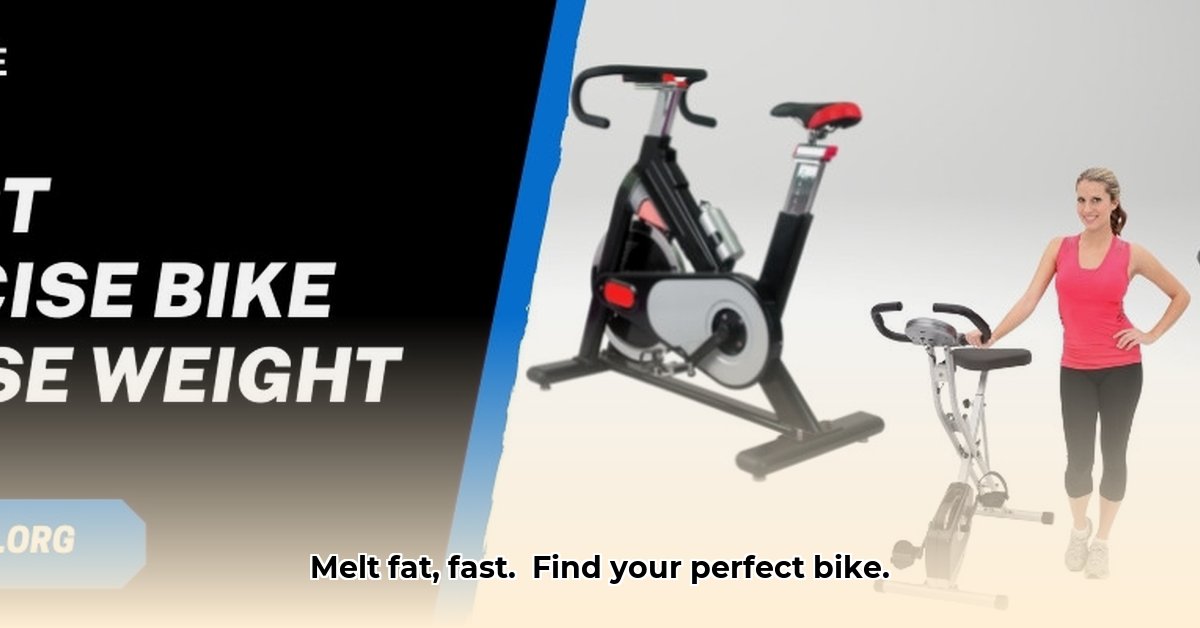
Ready to pedal your way to a healthier you? Choosing the right exercise bike can significantly impact your weight loss journey. This guide will help you navigate the options, find the perfect fit, and start your fitness adventure with confidence.
Understanding Your Needs: The First Pedal
Before diving into models, let's define your fitness profile. Are you a casual user or a dedicated athlete? This will heavily influence your bike selection.
Casual Riders: If you plan on using the bike a few times a week for light cardio, a basic, budget-friendly model will likely suffice. Comfort and ease of use are key considerations.
Dedicated Athletes: For regular, intense workouts, you'll want a bike with adjustable resistance, perhaps app integration for structured programs, and a robust build.
Tech-Savvy Fitness Enthusiasts: If data tracking and interactive workouts motivate you, prioritize bikes with advanced consoles, app connectivity, and features like heart rate monitoring.
Beyond your usage, consider these factors:
Budget: Set a realistic budget. Prices range from a few hundred to several thousand dollars.
Space: Measure your available space. Some bikes have a larger footprint than others.
Workout Preferences: Do you prefer structured classes or self-directed workouts?
Key Features: Building Your Perfect Ride
Several key features distinguish high-quality exercise bikes from basic models. Focusing on these aspects will ensure a comfortable and effective workout experience.
Resistance System (The Engine): Magnetic resistance systems generally offer a smoother, quieter, and more consistent workout than friction-based systems. They provide a more natural pedaling feel.
Flywheel Weight (The Momentum): A heavier flywheel provides a more stable and realistic riding experience, minimizing jerky movements and making for a more comfortable ride.
Console and Display (Your Dashboard): An easy-to-read console displaying time, distance, calories burned, heart rate, and other relevant metrics is essential for tracking progress and maintaining motivation.
App Integration (Your Digital Trainer): Many bikes offer app connectivity, providing access to guided workouts, training plans, and performance tracking. Consider whether these features align with your workout style and if the subscription cost is justified.
Seat Comfort (Your Throne): A comfortable and adjustable seat is crucial, especially for longer workouts. Look for well-padded seats with adjustable height and tilt.
Adjustability (Finding Your Fit): Adjustable handlebars and seats ensure proper posture and accommodate different body sizes and preferences.
Warranty (Peace of Mind): A good warranty protects your investment and provides assurance in case of mechanical issues.
Top Models: A Quick Overview
Here are a few popular models to illustrate the variety available. Remember, the "best" bike is subjective and depends on your individual needs.
| Model | Pros | Cons | Approximate Price Range (USD) |
|---|---|---|---|
| Peloton Bike+ | Immersive workouts, high-quality build, excellent app integration | High price, requires subscription, large footprint | $2000 - $3000 |
| NordicTrack S22i | Large screen, iFit app integration, diverse workout options | High price, large footprint | $1500 - $2000 |
| Schwinn 170 | Affordable, reliable, sturdy build | Basic console, limited features | $500 - $800 |
| Yosuda Exercise Bike | Budget-friendly, compact, ideal for beginners | Less durable than premium models, basic features | $200 - $400 |
Your Step-by-Step Guide to the Perfect Bike
Finding the right exercise bike is a process. This structured approach will help you make an informed decision.
Assess Your Needs: Define your budget, available space, and fitness objectives.
Research Models: Explore different models based on your criteria. Compare features and specifications.
Read Reviews: Consult independent reviews from reputable sources to get a balanced perspective.
Create a Comparison Chart: Compile a chart highlighting the pros and cons of different models based on your prioritized features.
Test Ride (if Possible): If possible, test ride several bikes to assess comfort and ergonomics.
Make Your Purchase: Choose the bike best suited to your needs and budget.
Stay Consistent: Remember, consistency is key to successful weight loss. Develop a workout plan and stick to it!
App Features and Subscription Costs: A Deeper Dive
Many connected bikes offer app integration, but understanding the features and subscription costs is crucial.
Key Considerations:
Workout Library Size: Does the app offer a wide variety of classes, catering to different fitness levels and preferences?
Personalized Coaching: Does the app provide tailored workout recommendations based on your progress and goals?
Community Features: Do you value connecting with other users through leaderboards, challenges, or social features?
Subscription Cost: Compare the monthly or annual subscription costs across different platforms and assess if the added features justify the expense. Often, non-connected bikes offer a significantly lower total cost of ownership.
Remember, the best exercise bike for weight loss is the one you will use consistently and enjoy. Happy cycling!